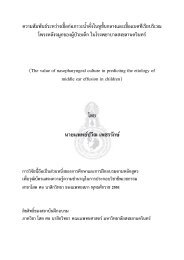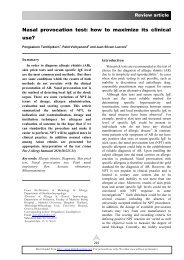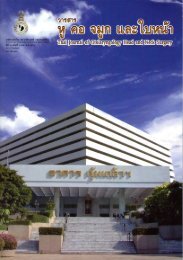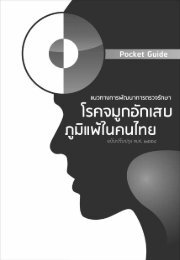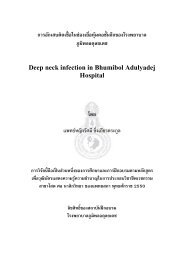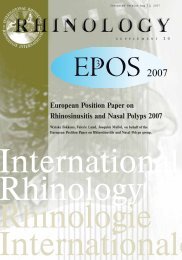Download File - ราà¸à¸§à¸´à¸à¸¢à¸²à¸¥à¸±à¸¢ à¹à¸ªà¸ ศภà¸à¸²à¸ªà¸´à¸à¹à¸à¸à¸¢à¹ à¹à¸«à¹à¸à¸à¸£à¸°à¹à¸à¸¨à¹à¸à¸¢
Download File - ราà¸à¸§à¸´à¸à¸¢à¸²à¸¥à¸±à¸¢ à¹à¸ªà¸ ศภà¸à¸²à¸ªà¸´à¸à¹à¸à¸à¸¢à¹ à¹à¸«à¹à¸à¸à¸£à¸°à¹à¸à¸¨à¹à¸à¸¢
Download File - ราà¸à¸§à¸´à¸à¸¢à¸²à¸¥à¸±à¸¢ à¹à¸ªà¸ ศภà¸à¸²à¸ªà¸´à¸à¹à¸à¸à¸¢à¹ à¹à¸«à¹à¸à¸à¸£à¸°à¹à¸à¸¨à¹à¸à¸¢
Create successful ePaper yourself
Turn your PDF publications into a flip-book with our unique Google optimized e-Paper software.
24วารสาร หู คอ จมูก และ ใบหน้าปีที่ 10 ฉบับที่ 3 ก.ค. - ก.ย. 2552Abstract : Bacteremia after tonsillectomyJirasak Angklomkleaw MD.*Objective : To study an incidence of bacteremia in post-operative tonsillectomy patients and find aproper prophylactic antibiotics for tonsillectomy.Method : Prospective study in patients who had tonsillectomy between May 2009 to July 2009 inNangrong Hospital. Compare the result of post-operative aerobic hemoculture with aerobic tissueculture from core of tonsil. The incidence of bacteremia and antibiotic sensitivity test were analysedby percentile.Result : The most common organism from core tonsil culture are P. aeruginosa (35%, 7 of 20), S.aureus (25%, 5 of 20), S. pyogenes (20%, 4 of 20)/ K. pneumoniae(20%, 4 of 20) / P. mirabilis(20%, 4 of 20). There were 6 mixed organism patients (30%). The highest sensitivity antibiotic aregentamicin, 3 rd generation cephalosporins, ciprofloxacin (65.4%, 17 of 26) and Cotrimoxazole (50%,13 of 26). The highest resistant antibiotic is ampicillin (30.8%, 8 of 26). There is 5% incidence ofpost operative bacteremia in tonsillectomy patients (P. aeruginosa, 1 of 20). This organism was sensitiveto gentamicin, 3 rd generation cephalosporins, ciprofloxacin and no evidence of drug resistance.Conclusion : There is low risk (5%) of bacteremia in post tonsillectomy patients and the proper prophylacticantibiotics are gentamicin, 3 rd generation cephalosporins or ciprofloxacin.Keywords : Bacteremia, tonsillectomy, post-operative, Bacteria*Otolaryngologist, Nangrong Hospital, Buriram



